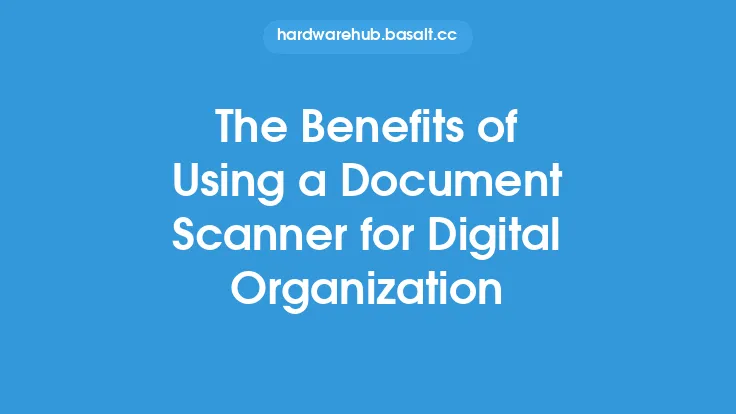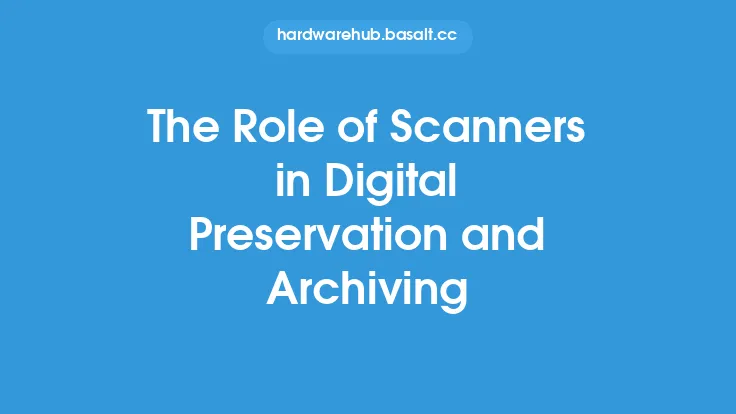When it comes to scanning documents and images, there are two primary types of scanners that individuals and businesses can choose from: flatbed scanners and document scanners. Both types of scanners have their own unique features, advantages, and disadvantages, and the right choice for a particular user depends on their specific needs and requirements. In this article, we will delve into the details of flatbed scanners and document scanners, exploring their differences, similarities, and the scenarios in which one might be preferred over the other.
Introduction to Flatbed Scanners
Flatbed scanners are one of the most common types of scanners available in the market. They consist of a flat glass surface, known as the scan bed, where the document or image to be scanned is placed. The scanner then moves a light source and a charge-coupled device (CCD) or contact image sensor (CIS) underneath the glass to capture the image. Flatbed scanners are known for their high-quality scans, versatility, and ability to scan a wide range of documents and images, including photos, books, and even objects. They are often used in homes, offices, and professional settings, such as graphic design studios and photography labs.
Introduction to Document Scanners
Document scanners, on the other hand, are specialized scanners designed specifically for scanning documents, such as letters, contracts, and reports. They typically use a sheet-fed or automatic document feeder (ADF) design, where the documents are fed into the scanner and scanned automatically. Document scanners are optimized for scanning text-based documents and are often used in offices, businesses, and organizations where large volumes of documents need to be scanned and digitized. They are known for their speed, efficiency, and ability to scan multiple pages at once, making them ideal for high-volume scanning applications.
Key Differences Between Flatbed Scanners and Document Scanners
One of the main differences between flatbed scanners and document scanners is their design and functionality. Flatbed scanners are designed for scanning a wide range of documents and images, while document scanners are specialized for scanning text-based documents. Flatbed scanners typically have a higher optical resolution, which allows for more detailed and accurate scans, while document scanners often have a lower optical resolution but are optimized for speed and efficiency. Another key difference is the scanning process itself. Flatbed scanners require the user to place the document or image on the scan bed and then scan it, while document scanners use an ADF or sheet-fed design to scan multiple pages at once.
Scanning Resolution and Quality
When it comes to scanning resolution and quality, flatbed scanners generally have an advantage over document scanners. Flatbed scanners can typically scan at higher optical resolutions, such as 1200 dpi or 2400 dpi, which allows for more detailed and accurate scans. Document scanners, on the other hand, often have lower optical resolutions, such as 300 dpi or 600 dpi, which is sufficient for scanning text-based documents but may not be suitable for scanning images or documents that require high levels of detail. However, some high-end document scanners can scan at higher resolutions, such as 1200 dpi, and may also include features such as optical character recognition (OCR) and image enhancement.
Speed and Efficiency
Document scanners are generally faster and more efficient than flatbed scanners, especially when it comes to scanning large volumes of documents. They can scan multiple pages at once, using an ADF or sheet-fed design, and can often scan at speeds of up to 50 pages per minute (ppm) or more. Flatbed scanners, on the other hand, require the user to place each document or image on the scan bed and then scan it, which can be a more time-consuming process. However, some flatbed scanners may include features such as batch scanning or automatic scanning, which can help to improve speed and efficiency.
Connectivity and Compatibility
Both flatbed scanners and document scanners can connect to computers and other devices using a variety of interfaces, such as USB, Ethernet, and Wi-Fi. They may also include software and drivers that allow for compatibility with different operating systems and applications. Some scanners may also include features such as cloud connectivity, mobile scanning, and wireless scanning, which can make it easier to scan and share documents and images.
Conclusion
In conclusion, flatbed scanners and document scanners are both useful tools for scanning documents and images, but they have different strengths and weaknesses. Flatbed scanners are ideal for scanning a wide range of documents and images, including photos and objects, and are known for their high-quality scans and versatility. Document scanners, on the other hand, are specialized for scanning text-based documents and are optimized for speed and efficiency. They are ideal for high-volume scanning applications and are often used in offices, businesses, and organizations. By understanding the differences between flatbed scanners and document scanners, individuals and businesses can choose the right scanner for their specific needs and requirements.





